| January 11, 2019
We ride and rate the latest crop of motocross bikes in our 2019 250cc motocross shootout.
We rounded up six bikes to face off in our 2019 250cc motocross shootout. We have the Honda CRF250R vs. Kawasaki KX250 vs. Suzuki RM-Z250 vs. Yamaha YZ250F vs. KTM 250 SX-F vs. Husqvarna FC 250.
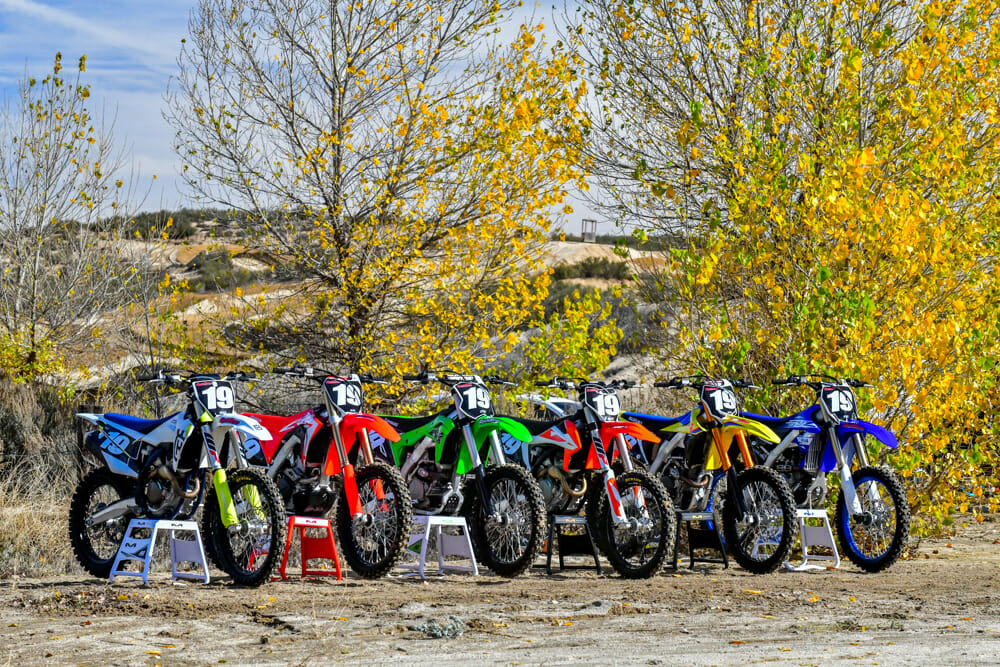 We have six bikes facing on in the Cycle News 2019 250cc motocross shootout.
We have six bikes facing on in the Cycle News 2019 250cc motocross shootout.
And they’re off. Similar to a high-dollar horse race, the 250cc motocross class is a neck-and-neck battle against the best on the planet. Six eager contenders are ready to break out of the stables and strut their stuff around some of the toughest tracks in Southern California—Cahuilla Creek and Glen Helen in particular. Developmental teams have been refining these bikes for years, making them the most advanced stampede of 250cc four-stroke motocrossers we’ve seen to date. This year each manufacturer means business and we will share our feedback in our 2019 250cc MX shootout.
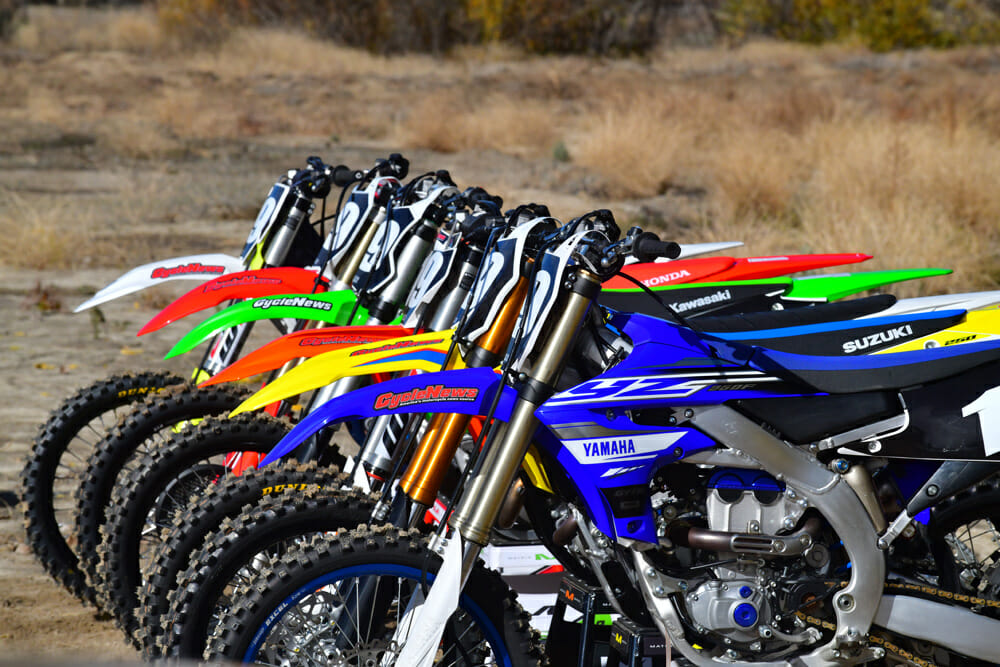
We’ve corralled these bikes together and kept them in stock trim, just as they’d be off the showroom floor. Our nine jockeys ranged from current pros to novice racers and everything in between. To keep the playing field level, we took these bikes to two of the most well-rounded test tracks in So Cal and only allowed our riders to make the same changes that one could easily make at home—air pressure, suspension clickers, lever adjustments, etc. The 250cc Four-Stroke MX Shootout is anything but predictable despite what the spec sheets list. Read along to see how the 250’s true colors shined through once the gates dropped and the bikes hit the ground running.
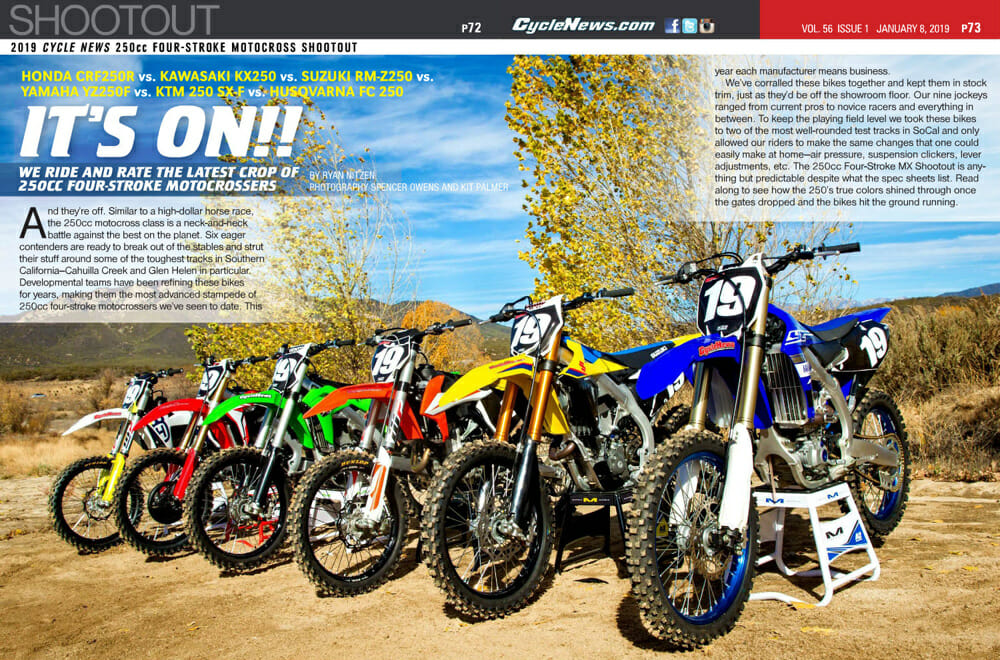
By Ryan Nitzen
PHOTOGRAPHY SPENCER OWENS AND KIT PALMER
THE PLAYING FIELD
2019 Suzuki RM-Z250 Specifications
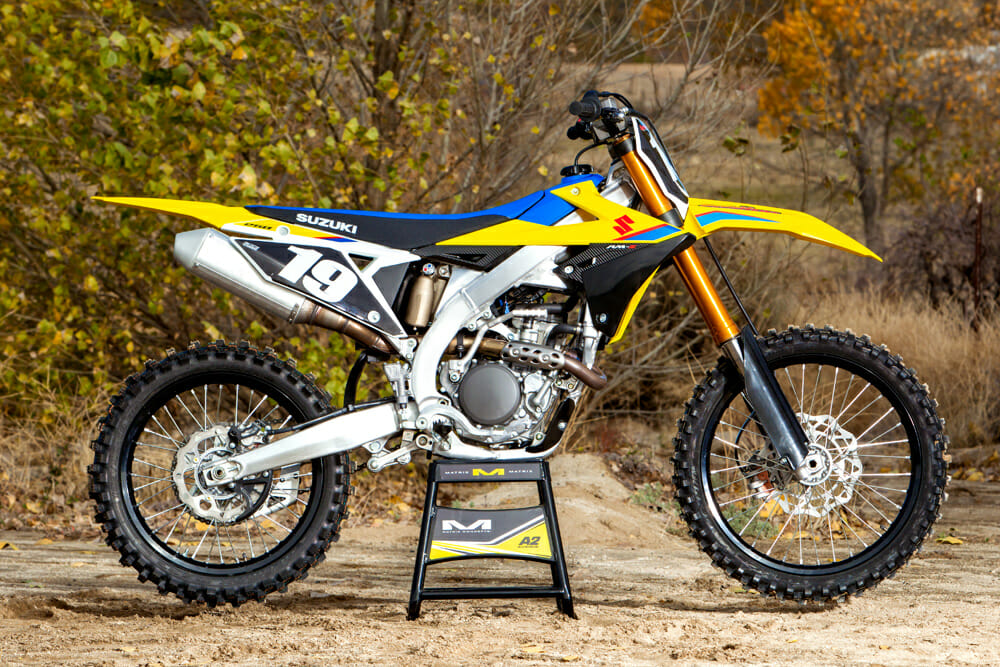
The Suzuki RM-Z250 boasts a brand-new look for 2019, taking styling cues from its newly updated 450cc counterpart. The new frame, swingarm, and plastics are first to catch the eye, while a new cylinder head and dual fuel-injection system are the biggest internal revisions. A new KYB rear shock and linkage system complement the coil-spring fork in the suspension department. The updated Suzuki still comes standard with a kickstarter and three fuel-coupler options.
Notable Features
- KYB spring fork
- Plug-In Fueling Couplers
- Suzuki-Holeshot Assist Control (S-HAC)
- Aluminum Twin-Spar Frame
- Tapered Aluminum Renthal Fatbar Handlebars
- Manual Starting
Important Numbers
- Weight: 238 lbs. (wet)
- MSRP: $8949
2019 Kawasaki KX250 Specifications
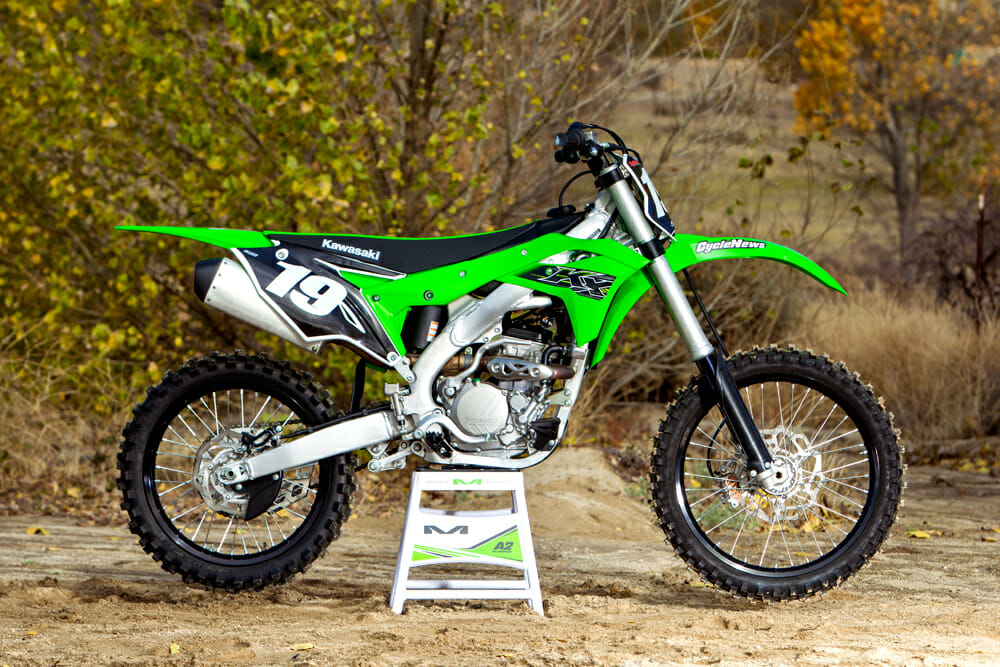
Team Green enters the 2019 shootout with minimal changes from a year ago. In fact, the KX only sees a name change (dropping the “F”) and a set of mold-in graphics. Its dual fuel-injection system highlights the engine package while slim ergonomics make it one of the narrowest bikes in the class. Kawasaki’s Ergo-Fit adjustable handlebar and footpeg mounts aid in fitting the 250 to a variety of riders. Like the Suzuki, the KX250 is equipped with a kickstarter along with three plug-and-play fuel couplers.
Notable Features
- Showa SFF Type 2 Spring Fork
- Plug-In Fueling Couplers
- Multiple Rider Compartment Adjustability
- Aluminum Perimeter Frame
- Renthal Aluminum Handlebars
- Manual Starting
Important Numbers
- Weight: 234 lbs. (wet)
- MSRP: $7749
2019 Honda CRF250R Specifications
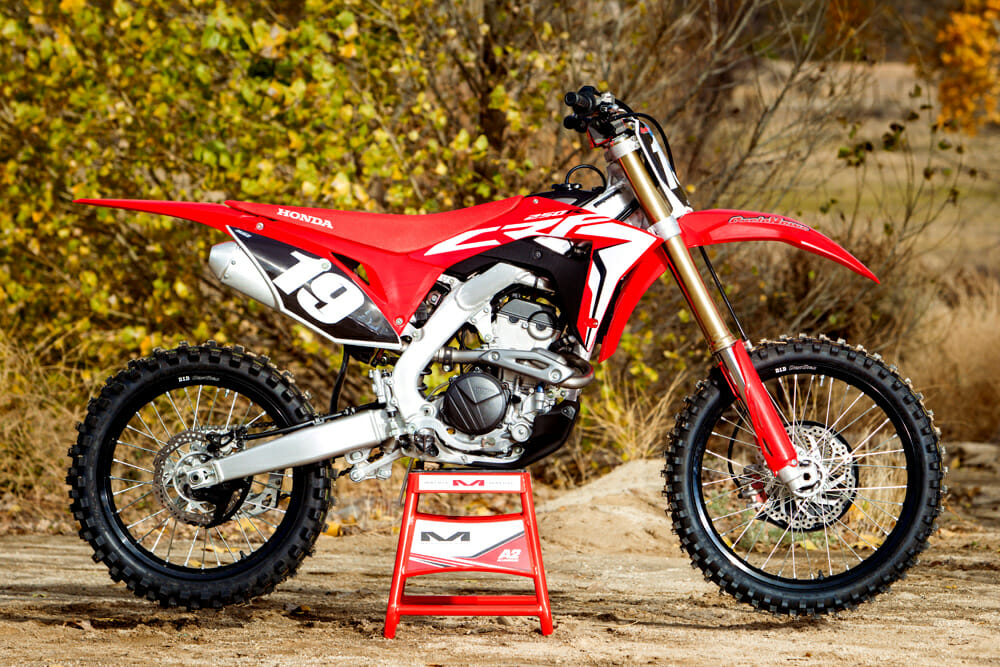
Honda had zero time to rest since last year’s shootout, going back to the drawing board and arriving with a list of significant updates. The CRF250R continues on using the DOHC engine layout, though revising it with updated cam profiles, a smaller throttle body with double-spray injectors, and gear-specific ECU engine mapping. Black D.I.D rims are another stylish new addition for ’19. Couple these changes with an already-strong chassis package and it could be just what Big Red needs to get back to the top.
Notable Features
- Electric Starting
- Handlebar Map Switch
- Dual Exhaust System
- Titanium Fuel Tank
- DOHC Engine
- Showa 49mm A-Kit-Style Coil-Spring Fork
- Aluminum Handlebars
Important Numbers
- Weight: 238 lbs. (wet)
- MSRP: $7999
2019 Yamaha YZ250F Specifications
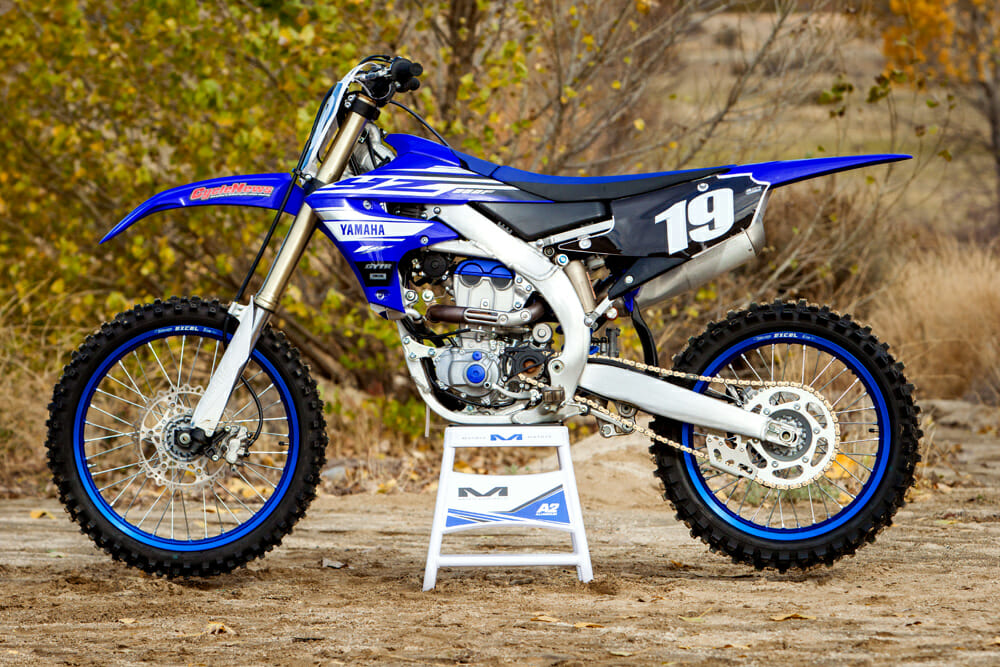
The Blu Cru arrived in the 2019 with a fully redesigned YZ250F, finally retiring the platform that dominated the class until 2018. The ’19 YZ sees new engine, frame, and bodywork designs, while continuing to ride on the same KYB suspension package. No shame in staying consistent here though: the YZ is known for having the best-in-class handling. Yamaha also finally fitted the YZ250F with an electric starter and made the bike compatible with their Power Tuner smartphone app.
Notable Features
- Electric Starting
- KYB Speed Sensitive System (SSS) Spring Fork
- Reverse Cylinder Design
- Reward-Inclined Cylinder
- Tapered Aluminum Handlebars
- Engine Tuning App
- Two Color Options (blue, white)
Important Numbers
- Weight: 238 lbs. (wet)
- MSRP: $8199
2019 Husqvarna FC 250 Specifications
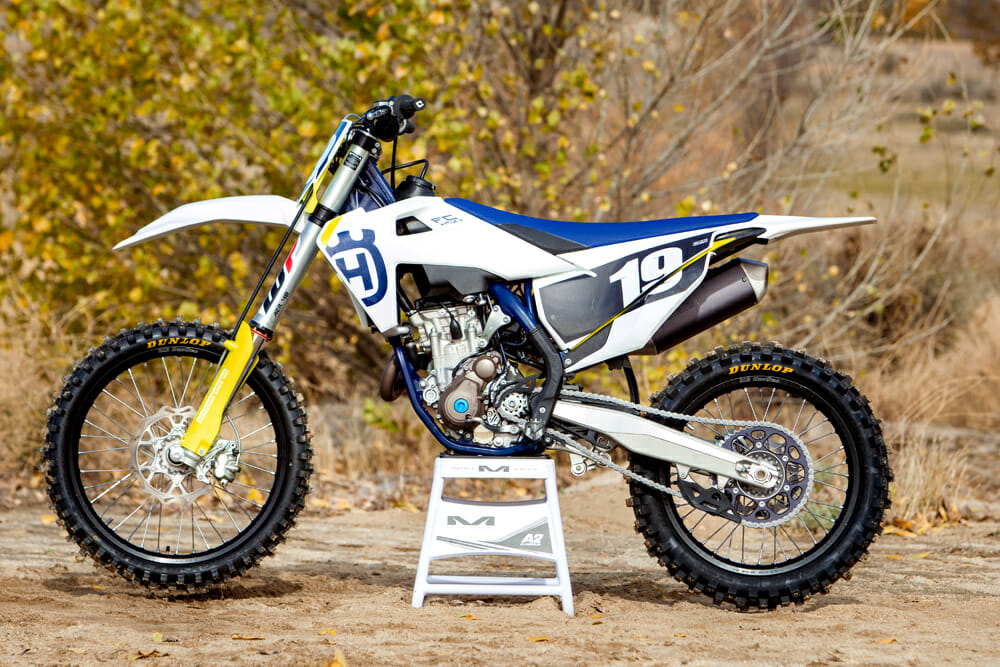
Despite what the spec sheets say, the Husqvarna FC 250 is its own motorcycle—not just a white KTM. The Husqvarna varies from its Austrian counterpart in small details that equal big differences, specifically the Magura hydraulic clutch (instead of the Brembo unit on the KTM), composite subframe, and Pro Taper handlebars. For ’19, the FC gets an updated steel frame, updated engine mapping, and a redesigned exhaust system. Husqvarna took victory in last year’s shootout, but are these changes enough to keep it there?
Notable Features
- WP AER 48 Air Forks
- Handlebar Map Switch
- Launch Control
- Traction Control
- Electric Starting
- Hydraulically Operated DDS Clutch
- Chromoly Steel frame
- Composite Subframe
- Neken Tapered Aluminum Handlebars
- ODI Lock-On Grips
Important Numbers
- Weight: 233 lbs.
- MSRP: $9099
2019 KTM 250 SX-F Specifications
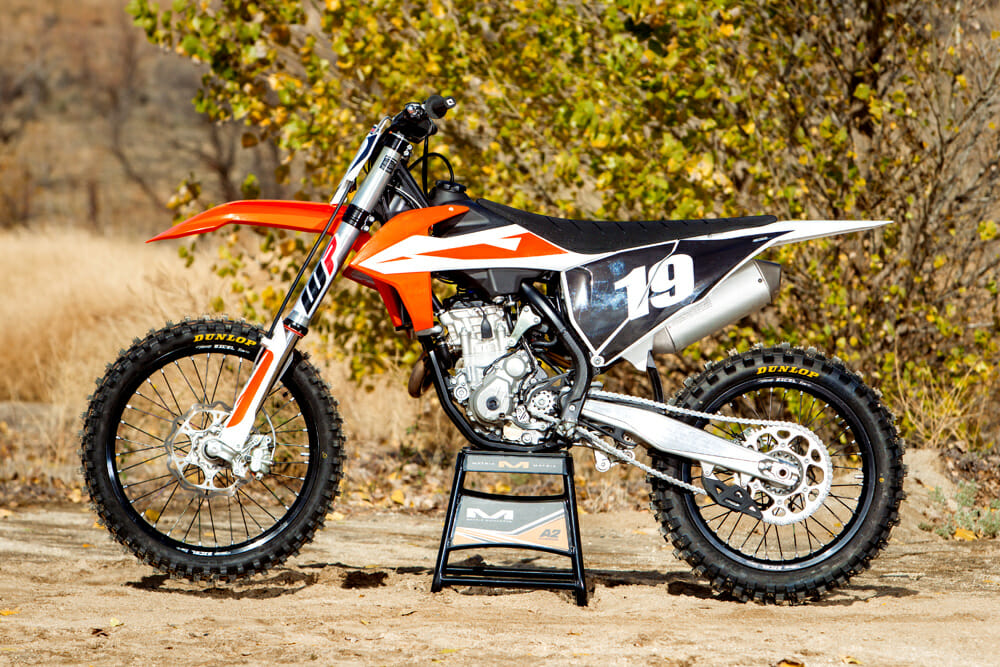
The Orange Brigade came up short in last year’s shootout but is out to change that this time around with an updated 2019 250 SX-F. The KTM is arguably the fastest in the class and tips the scales lighter than the competition. New for this year is a revised steel frame, updated seat shape, and more efficient radiator design. The Brembo brakes, hydraulic clutch, and WP AER 48 forks are familiar components from year’s prior, meaning KTM left the positives of the SX-F untouched.
Notable Features
- WP AER 48 Air Forks
- Handlebar Map Switch
- Launch Control
- Traction Control
- Electric Starting
- Hydraulically Operated DDS Clutch
- Chromoly Steel frame
- Aluminum Subframe
- Neken Tapered Aluminum Handlebars
- ODI Lock-On Grips
Important Numbers
- Weight: 232 lbs. (wet)
- MSRP: $8999

6th Place | Suzuki RM-Z250
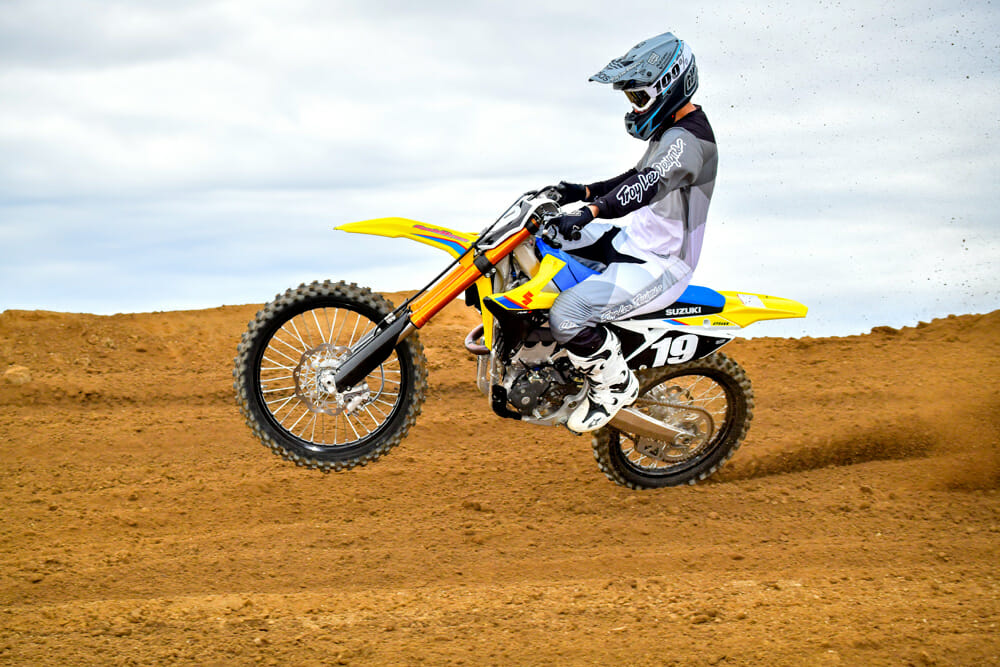
It’s no secret that last year’s RM-Z250 was outdated when compared to the competition. Suzuki went back to the drawing board, outfitting the small-bore RM-Z with a redesigned chassis, updated suspension package, and revised engine. This is Suzuki’s attempt at moving itself back to the forefront of the class.
Unfortunately, the RM-Z still finds itself slightly off the pace, though it is a much-improved motorcycle. In a field where the leaders come standard with electric start, on-the-fly map adjustments, and trick suspension components, we could only expect the Suzuki to go so far. Despite a sixth-place finish in this year’s shootout, this bike isn’t likely to be found in the back of the pack at your local race—this thing has potential.
The RM-Z’s engine package is one of the biggest improvements for the new year, most notably a stronger initial throttle response followed by an improved midrange pull. That extra pull helps accelerating away from corners and gave it some extra grunt when clearing jumps from the inside line. The top-end power doesn’t fall flat either, giving it extra steam down the long straights, but still suffering in comparison to its competitors. Even with the added horses, the RM-Z’s powerband remains ultra-linear and rider friendly; a well-liked characteristic by vet and novice level riders.
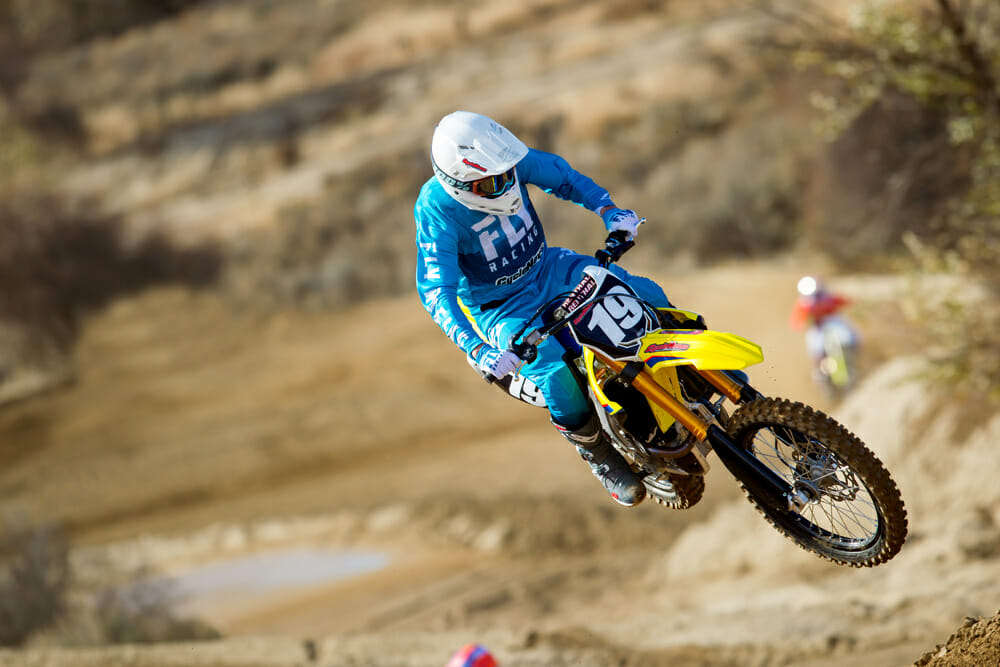 Despite getting a major overhaul, the 2019 RM-Z250 is still missing a few key ingredients, such as electric starting and handlebar map switching. On-track performance, however, is much improved over the previous model, but suspension still needs some sorting out. It gets double thumbs up for being the least expensive of the group.
Despite getting a major overhaul, the 2019 RM-Z250 is still missing a few key ingredients, such as electric starting and handlebar map switching. On-track performance, however, is much improved over the previous model, but suspension still needs some sorting out. It gets double thumbs up for being the least expensive of the group.
Sixth place or not, it’s arguable that the Suzuki has the most-balanced chassis in the class. At 238 pounds, the bike is a bit on the heavy side but still has the ability to corner with the best of them. Mid-corner steering is like a doctor’s scalpel in ruts, berms, and everything in between, even if it takes some extra effort to get it leaned over. In the rough stuff, the forgiving chassis eats up bumps and remains in line. The rider cockpit, more specifically, the bar-to-peg ratio, fit riders of all sizes with minimal adjustments. All of the Cycle News test riders liked the RM-Z’s “pocket” thanks to updates to the frame and bodywork.
With the re-design, we found some growing pains within the new RM-Z. The new KYB spring fork and shock were too harsh out of the box for even our fastest riders. Our designated pro riders noticed the forks lacking small-bump compliance, suggesting the bike comes “over-valved.” This created unwanted harshness in high-speed sections with downhills and braking bumps. To compromise the stiff forks, our riders made many clicker adjustments and stiffened the rear end to even out the overall ride.
The lack of electric start and the outdated fuel-coupler system are undoubtedly the Suzuki’s biggest setbacks. Note the new RM-Z does have a holeshot-control button, but in a field where e-start and on-the-fly map adjustments are the current norm, the RM-Z is still lacking even after its 2019 overhaul.
With that being said, the yellow machine is still considerably less expensive than most of its competitors, making it an attractive platform for novice riders or those looking to race on a budget. Its rider-friendly power and forgiving chassis design are also big pluses for smaller riders making the jump from mini bikes. The Suzuki finds itself in sixth place again this year but makes significant strides toward being a top contender.
5th Place | Kawasaki KX 250
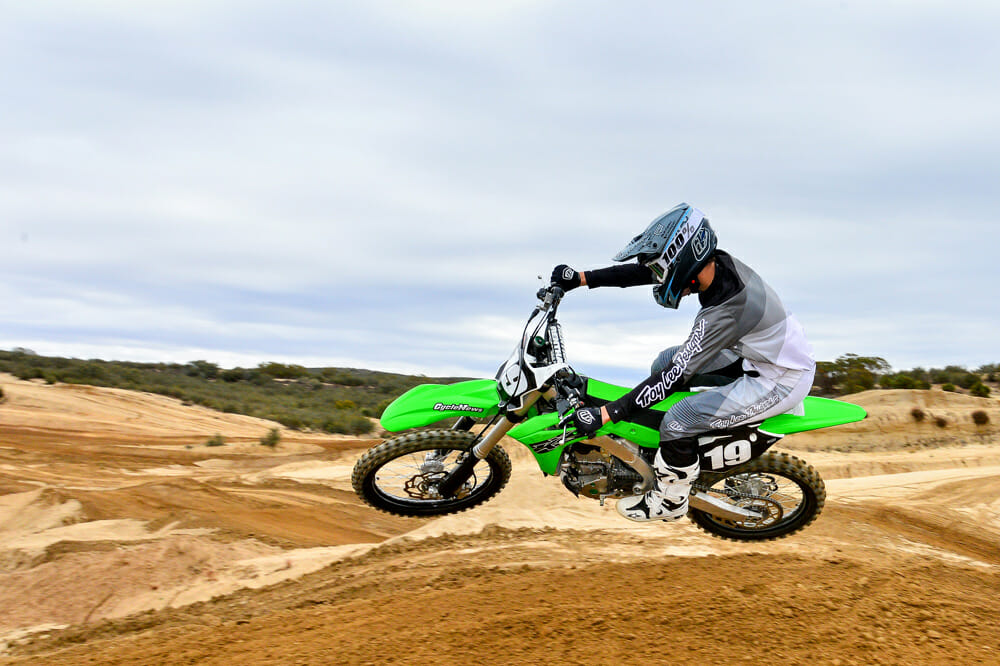
There’s no time to settle in the small-bore motocross class. Without relentless R&D updates, bikes are left fighting for scraps at the back of the pack. This is the current situation with the Kawasaki KX250. While the competition improves upon their respective platforms, Team Green enters the 2019 250cc Motocross Shootout with an identical bike as the year before—sans a name change and bold new set of in-mold graphics.
The KX250 has found its niche in the class earning the nickname of the “do-it-all” machine in this year’s shootout. Does it do everything well? Yes. But without any significant changes, it’s not surprising that this bike finished in the same spot it did last year. It’s a capable all-around package, but lacks that last bit of performance needed to compete with frontrunners.
The Kawasaki’s engine comes on strong at the bottom end, accelerating hard out of the corners and pulls quickly through the midrange rpms. Then, it runs into trouble. As the revs near the redline, the KX250 runs out of steam, hindering outright speed in high-speed straightaways and hillclimbs. A switch to the optional aggressive fuel coupler helps here, giving the Kawasaki noticeably more life through its powerband.
Short transmission ratios also don’t help with the Kawasaki’s lack of top-end pull. The green machine runs into the next gear sooner than its competitors, forcing riders to make extra shifts throughout the course of a lap. This may not be a bother at first, but is fatiguing during a long moto.
A slim and predictable chassis helps combat that fatigue as the KX finds a balance between high-speed stability and nimble handling in tight sections. A flat seat and narrow fuel tank allow for effortless transitions in the rider cockpit. It’s easy to manipulate and tracks straight in chop. In short, you ride the bike versus the bike riding you. The Showa SFF Fork is harsh in the initial stroke through braking bumps, but also struggles with bottom-of-stroke support on big hits and hard landings. After fiddling with the compression and preload adjustments, riders found a more balanced feeling that worked well in all areas.
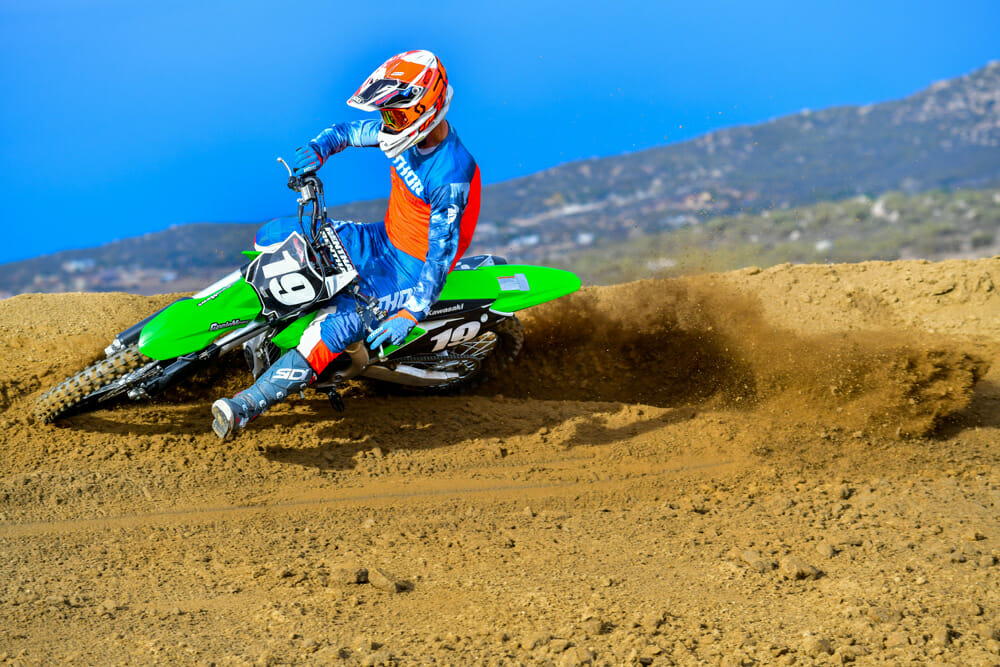 Like the Suzuki, the 2019 Kawasaki KX250F lacks electric starting and a handlebar map switch but makes up for these things with solid overall performance on the track. The KX also has multiple adjustments to make things as comfortable as possible in the cockpit.
Like the Suzuki, the 2019 Kawasaki KX250F lacks electric starting and a handlebar map switch but makes up for these things with solid overall performance on the track. The KX also has multiple adjustments to make things as comfortable as possible in the cockpit.
Standout features on the Kawi? It’s hard to discount the Ergo-Fit system, which includes adjustable handlebar and footpeg mounts. The handlebar mounts can be flipped and the triple clamps offer two unique positions totaling 35mm of adjustable range. The footpegs also feature two positions—and while all our testers kept the pegs in the stock trim—taller riders may find this to be a useful resource. The handlebar-mounted launch control is also a standard feature on the Kawasaki.
Where the Kawasaki falls short is, like the RM-Z, its lack of electric start and outdated fuel-coupler system. In year’s prior, we would overlook these shortcomings, but the current crop of frontrunners are making them a must-have just to compete in 2019.
Lack of updates or not, the Kawasaki is still a strong all-around package that’s capable of running at the front of any given race—it’s in the finer details that 2019 KX 250 comes up short. Considering that the KX450 received a complete overhaul this year, we’re expecting Team Green will come out swinging with a more updated machine next year.
4th Place | Honda CRF250R
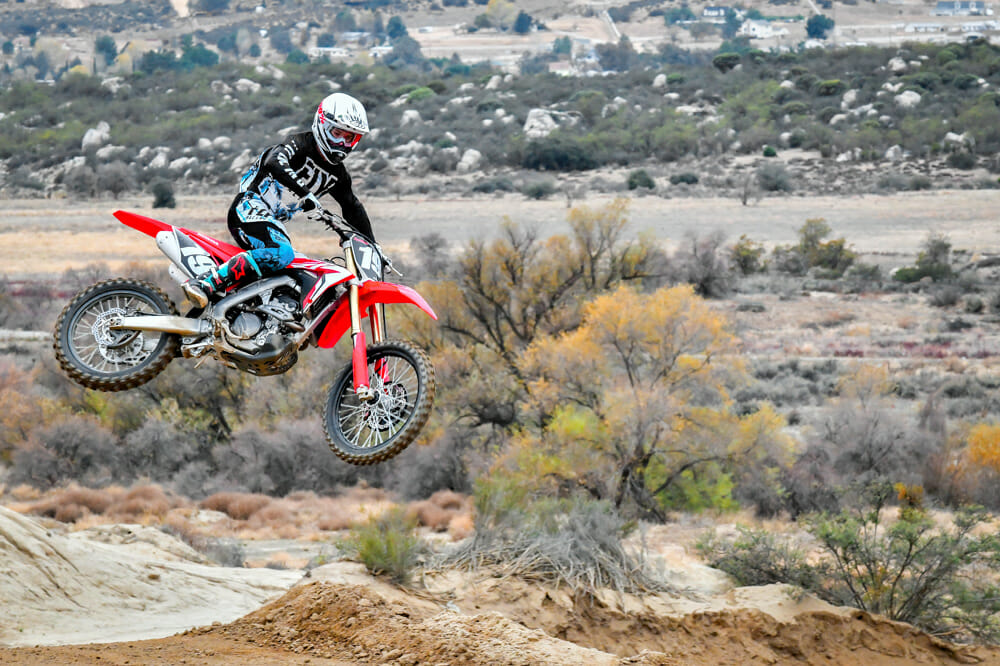
Big Red was firing on all cylinders in 2018, rolling out an all-new model and finishing third in last year’s Cycle News 250cc MX shootout. The CRF250R comes into ’19 with appreciated improvements aimed at finally overthrowing the Austrians in victory lane.
This high-revving racer gets bumped down one spot from last year, but not from a lack of trying. New gear-specific engine mapping, double-spray injectors, and an updated throttle body all add to the bike’s ability to make some serious mid-to-top horsepower. Honda continues to use their Dual Overhead Cam (DOHC) engine and the unique double exhaust system are other distinct features that set this bike apart from the rest of the 250 competition.
On track, its powerband behaves differently than the others, too. Initial power delivery hits hard, but is followed by a lackluster midrange pull. What’s strange is the power kicks back in near redline, offering a strong top-end pull before running into the next gear. That said, testers found that revving the Honda and feathering the clutch were the quickest ways around the track, but not necessarily the most efficient. Get it right and the CRF is a rocketship, but if you’re not in the optimum rpm range, you’ll find yourself struggling to keep up.
Thankfully, keeping corner speed up on the Honda is easier than most—and in typical Honda fashion, the bike seemed to read our riders’ minds, going simply wherever our eyes pointed. The Showa SPG coil-spring fork provided a planted feel around the track, performing best on rough downhills and corner entrances. Riders opted for inside lines on the Honda, as the well-balanced chassis and quality suspension components made it nearly effortless to lean the CRF250R on its side. Despite tipping the scales as one of the heaviest in the class at 238 pounds, the Honda’s agile personality makes it feel lighter than most on the track.
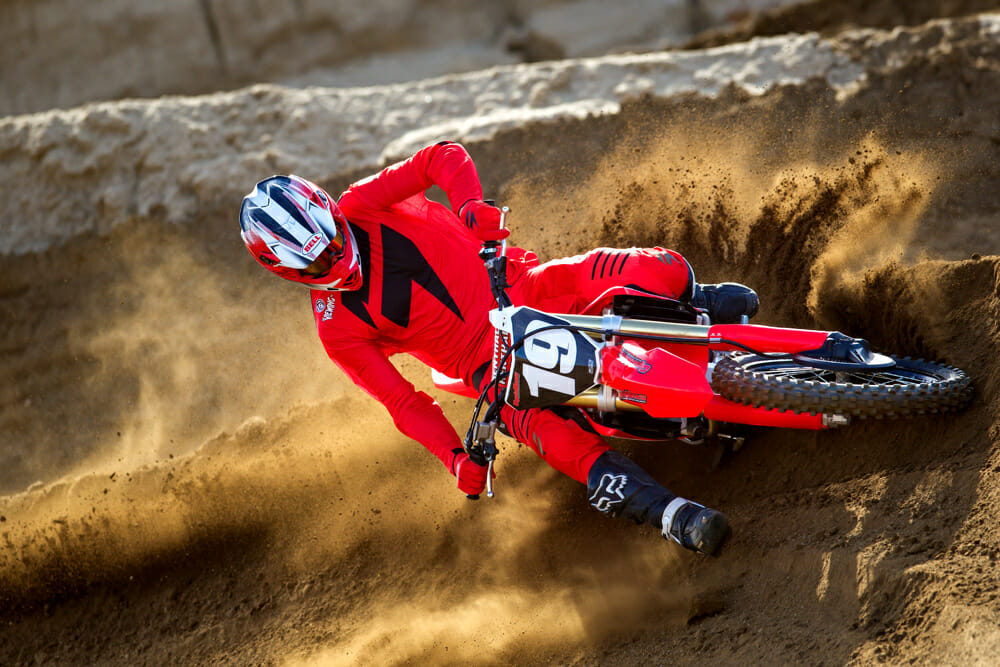 There is a lot to like about the 2019 CRF250R. The engine makes good power, especially from mid to top but can’t quite match the high-revving peak power of the KTM and Husqvarna, but nor to the other Japanese bikes. Suspension is very good and has excellent adjustability.
There is a lot to like about the 2019 CRF250R. The engine makes good power, especially from mid to top but can’t quite match the high-revving peak power of the KTM and Husqvarna, but nor to the other Japanese bikes. Suspension is very good and has excellent adjustability.
The convenience of the rider cockpit is strides ahead of the fifth- and sixth-place finishers. Renthal Fatbars are outfitted to the front of the Honda and are home to more useful buttons than a simple launch control and kill switch. The CRF is equipped with electric start and a three-mode map switch that blinks when selected. While it offers the convenience of a handlebar-mounted switch, this was our least favorite of said design. How so? In order to change modes, the bike must be in neutral and the blinking lights can be hard to see in the afternoon sun.
The Honda is undeniably a challenger for the crown in the 250 class, but a few small kinks held it back in this year’s shootout. The lack of refinement in the CRF’s powerband limits overall rideability and requires the bike to be ridden in the top-end power, making it difficult to suit riders of all skill sets. Having to slow down to operate the on-the-fly map switch (it has to be at idle) is another minus compared to our top two. Unfortunately, these minute characteristics hinder the bike’s results and shuffle it from being a frontrunner to a midpack finisher.
3rd Place | Yamaha YZ250F
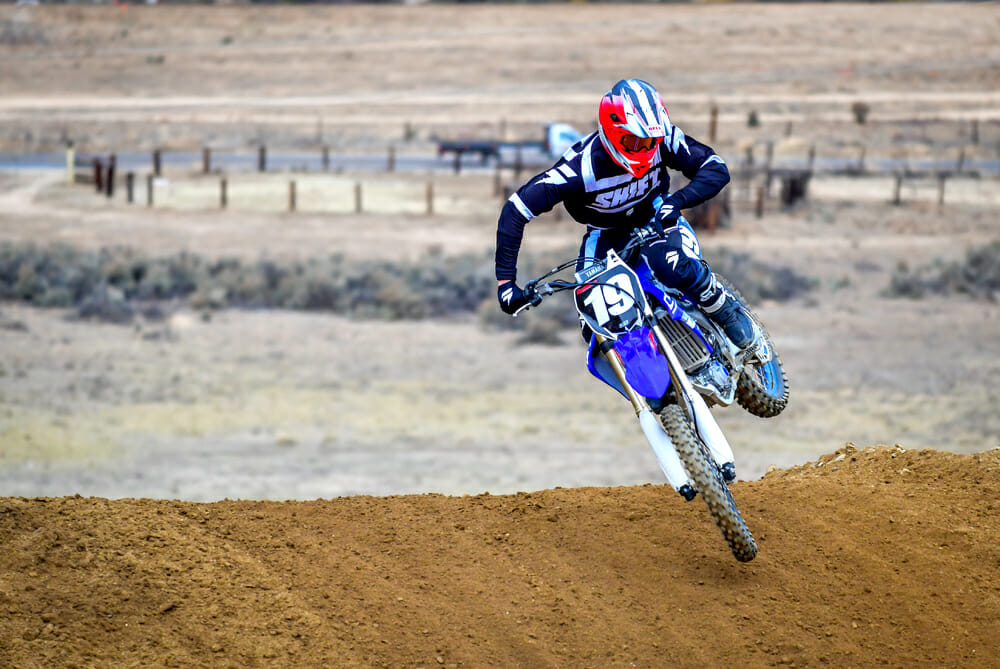
Throughout the 2019 250cc Motocross Shootout, the top three were neck and neck. A bike would jump ahead of the others in one area, only to be overtaken in another. As they neared the finish line, two accelerated away from the last, leaving it to take the final spot on this year’s podium. Enter the Yamaha YZ250F.
The Blu Cru revamped nearly everything on the new YZF, making it an all-new model for 2019. A new chassis and engine, along with a host of other updates, are noticeable the first time our riders swung a leg over. Despite a ground-up redesign, the YZF is still known as being best all-around packages. Some things never change.
The “all-new” Yamaha still sports some usual designs that die-hards will find familiar. The forward-facing air box, wraparound exhaust, and wider-style front end carry over from previous generations. New for Blue, however, is the electric start, Power Tuner App, and body styling that offers a one-piece shroud with easier access to the air filter.
If the 250 Shootout were left to suspension performance alone, the Yamaha would win hands down. The YZ250F retains the same KYB SSS fork that highlighted its handling in years previous, and received changes for the new model year to elevate its level that much further. What makes it so good? In box-stock trim, the suspension package offers an unbeatable balance of small-bump compliance and bottoming resistance on hard hits. Even with various skill sets and track conditions, most of our riders made minimal adjustments to the suspension settings.
Yamaha’s rejuvenated powerplant is one of the most rider-friendly in the class. The strong bottom-end torque transitions well to the powerful mid and top-end, still with plenty of over-rev, until it finally tapers off at redline. Our opinion? The Yamaha engine caters to the widest variety of riders, as it suited all of our testers and their individual abilities. The low-end grunt allows riders to lug the YZF around in low rpm, but faster riders will still appreciate the power up top, though it signs off a little sooner than the Austrian bikes.
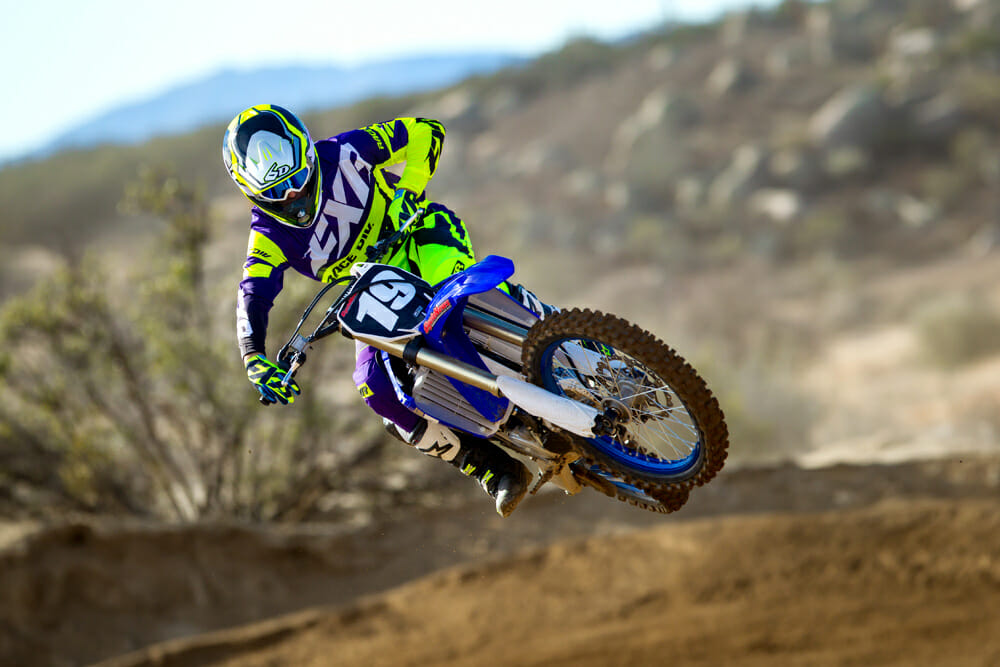 If suspension is the number-one factor for you, then the Yamaha will be your best friend. The 2019 Yamaha YZ 250F does pretty much everything else really well, too, but we recommend wearing earplugs on the Yamaha. It’s loud.
If suspension is the number-one factor for you, then the Yamaha will be your best friend. The 2019 Yamaha YZ 250F does pretty much everything else really well, too, but we recommend wearing earplugs on the Yamaha. It’s loud.
In creating the ’19 YZ250F, Yamaha made the bike compatible with the Power Tuner smartphone app, which was first introduced on the 2018 YZ450F. By using the app, riders are able to make custom changes to the bike’s EFI system, while sitting in the garage or trackside and instantly upload maps via the onboard WiFi. The app will also log the bike’s hours and inform owners of needed maintenance. Nice. The app might not be as easy to use as the KTM/Husqvarna two-map switch, but is way more tunable between motos.
So where does the Yamaha lose out in this year’s test? The YZF is annoyingly loud, plain and simple. A combination of the front-facing air box and exhaust pipe will leave riders wishing for a pair of blue earplugs to match their new YZF. All riders noticed the distressing decibel levels on the track, especially the faster they went. While an exhaust upgrade would likely fix this issue, we only tested these bikes back to back in stock form.
In hopes of reclaiming the class crown, Yamaha went all in redesigning the YZ250F for 2019. Unfortunately, the Blu Cru is having to hand its chips over once again. The YZF is a highly capable package, but two others performed just that much better.
2nd Place | Husqvarna FC 250
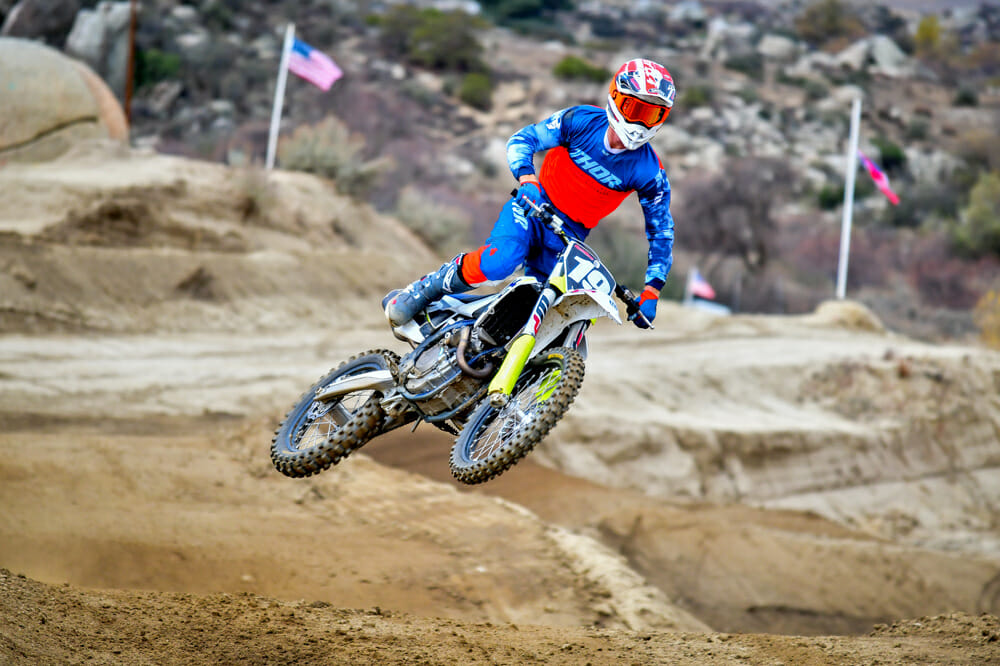
And then there were two. The 2019 Husqvarna FC 250 comes in at second place in the Cycle News 2019 250cc Motocross Shootout, even though it rolls off the same assembly line as its Austrian counterpart. But how can two nearly identical bikes stack up differently on the track? Subtle differences like the Husqvarna’s Magura clutch, composite subframe, Gripper seat cover, and Pro Taper handlebars do just enough to distinguish a winner and loser.
The European’s cockpit controls certainly have a stranglehold on the Japanese manufacturers. The Husky’s Magura hydraulic clutch is a nice touch, even if it struggles to provide the exact same feel as the Brembo unit equipped on the KTM. Thankfully, the FC 250 still comes standard with Brembo brakes and braided steel lines, which offer effortless pull at the lever that doesn’t fade under heavy load.
For ’19, the Husqvarna gets a stiffer and more stable steel frame paired with a unique carbon-fiber subframe. The combination of the two are said to improve overall energy absorption and rider comfort. On track, however, rider opinions were split two ways; some loved the rear-end feel of the Husky, while others said it felt too wide and grabbed at their boots when riding off the back of the bike. The seat cover, too, is overly sticky, which can fight the rider when shifting body weight. The chassis is nimble in tight corners, yet surprisingly stable at speed. These were two big confidence boosters as each rider hopped aboard this white stallion.
Riders who can carry speed and ride a high-revving machine are best suited for the Husqvarna and KTM powerplants. These engines produce their peak horsepower prior to reaching the bike’s 14,000-rpm redline, and offer two maps that encourage riding high in the rev. Each of the Austrian competitors come equipped with a traction-control feature, and while it may not be a must-have in the small-bore class, it was certainly useful in slippery track conditions. As the rear wheel begins to slip, the traction control limits power and helps drive the bike forward instead of sideways. This gave our riders some added courage when leaning the bike over in the off-camber and uphill corners.
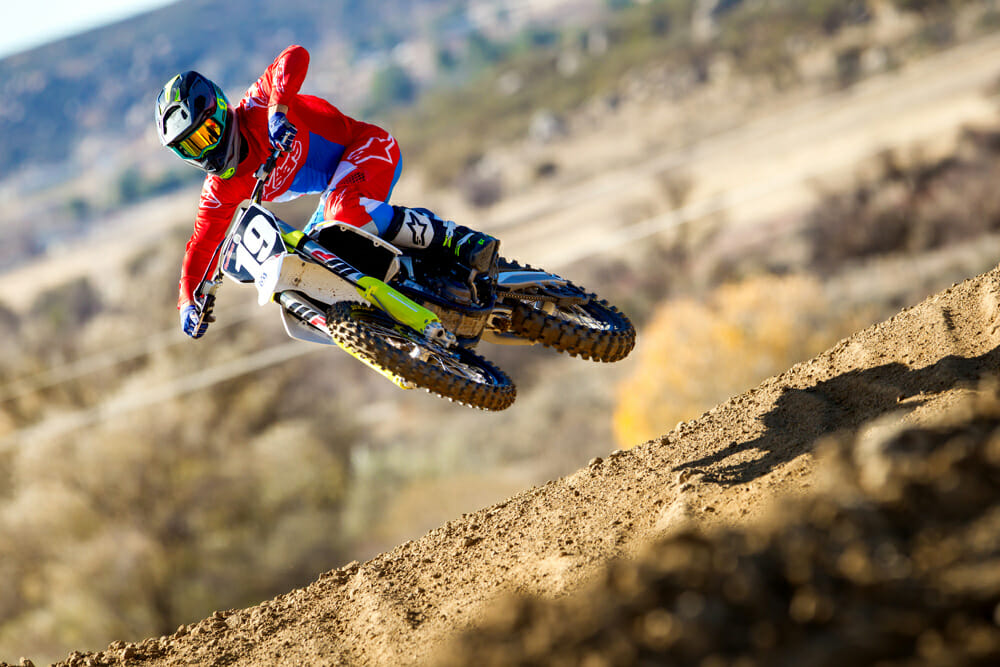 You want power? Then you’ll like the Husqvarna…and KTM. They share the same powerplant that makes the most seat-of-the-pants peak horsepower of the group, while still offering a wide and broad powerband. The Husqvarna’s unique composite subframe gives it its own feel, compared to the KTM.
You want power? Then you’ll like the Husqvarna…and KTM. They share the same powerplant that makes the most seat-of-the-pants peak horsepower of the group, while still offering a wide and broad powerband. The Husqvarna’s unique composite subframe gives it its own feel, compared to the KTM.
A two-mode engine map comes on the same switch as the traction control. This handlebar-mounted system lights up with a number one or a number two and can literally be changed in the air if a rider were to choose to do so. Even though it’s limited to only two modes, this push-button system is the easiest to use in the class.
The WP AER 48 air forks are another key aspect to the Husqvarna’s overall character. When combined with the WP DCC rear shock, you’ve got a lightweight setup that’s ready to handle small chop, but still stiff enough to tackle flat landings. An added bonus? The WPs are adjustable via hand clickers, meaning you don’t even need tools to make changes.
Finding faults in the 2019 Husqvarna FC 250 is a difficult thing to do. Seriously, it’s damn near identical to the bike that takes victory, but subtle differences like the Magura clutch feel, wide rear subframe, and overly textured/rough seat hinder its potential. Maybe next year, Husqvarna.
First Place | KTM 250 SX-F

There can only be one 2019 250cc Motocross Shootout winner, and the 2019 KTM 250 SX-F is just that. It’s the finest details that made the difference for the Orange Brigade, just slightly edging it out over the Husqvarna. Sure, the KTM produced a little more horsepower than its cousin and weighs slightly less, but is that really why it took victory? Not exactly. Here’s how the KTM came out on top.
This year’s 250 SX-F is the total package. It’s lightweight, powerful, and is as close as they come to being a full-fledged race bike right out of the box. The engine develops power nearly the same as the Husqvarna, revving high and catering to riders that can carry speed on the entrances and exits of corners. Its high-strung spirit rang clear around the sweeping corners at Cahuilla Creek and steep hills of Glen Helen. The transmission on the 250 SX-F is the smoothest of the bunch and lets the rider use every last horse. Most of our riders preferred the aggressive-map option, which gives the KTM a little more pep in its throttle delivery, but not enough to make it intimidating.
WP also supplies the suspension on the KTM, with the AER 48 Air Fork coming standard on the 250 SX-F. We found the fork to work exceptionally well with the updated chassis, requiring less changes to find an ideal setup than on the Husky. Riders could slice through lines with ease and adjust the fork on the fly without tools. The updated damping in the fork provided a reliable feel, as riders were able to “trust” the front end quicker than the other bikes.
Brembo handles the controls of the KTM. These top-notch products are placed in the hands of the KTM’s pilot and were preferred over the Magura unit on the Husqvarna. The smooth and simple feelings from both levers become second nature after a few corners and only get better once the arm pump sets in. Racers will no doubt be thankful for these features as they delve into those rough afternoon training sessions.
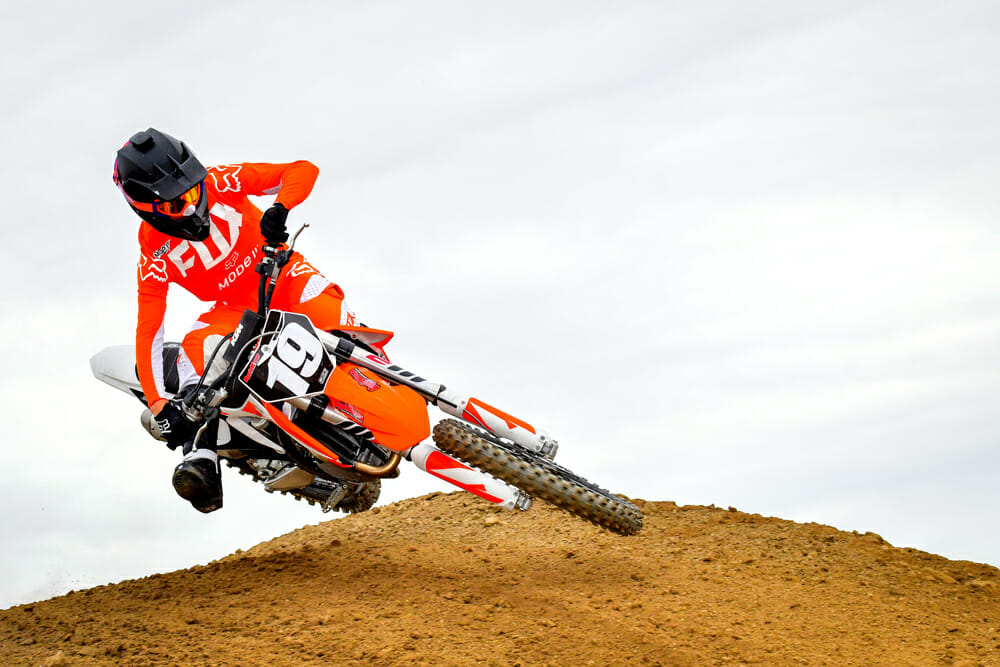 The KTM has many things to offer that the Japanese bikes don’t, such as on-the-fly mapping control, traction control, a hydraulically operated clutch, ODI Lock-On grips and a steel frame. Yes, it might cost the most but you get a lot—including excellent on-track performance—for your money.
The KTM has many things to offer that the Japanese bikes don’t, such as on-the-fly mapping control, traction control, a hydraulically operated clutch, ODI Lock-On grips and a steel frame. Yes, it might cost the most but you get a lot—including excellent on-track performance—for your money.
E-start, push-button map changes, and the option for traction control are other add-ons that you didn’t know you needed until throwing a leg over the KTM. Yes, these are the same ones found on the Husqvarna, and their seamless integration is an engineering feat on both machines. Combine that with the tool-free fork adjusters and air-box access, and you’ve got an overall package that’s the best of both worlds; ready to race and easy to work on.
In the end, it’s a close match up between the two Austrian machines. The KTM beat out its counterpart in only the finest details—the smoother action of the Brembo clutch assembly, superior WP box-stock suspension settings, and narrower chassis. Our riders found the 250 SX-F to be the bike that was easiest to go the fastest on, and isn’t that what wins races? The KTM’s “Ready to Race” mantra holds true as ever.CN